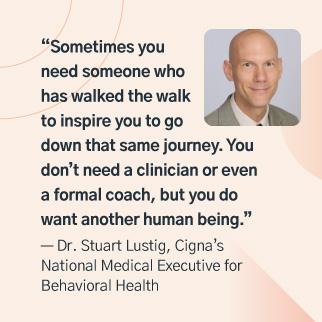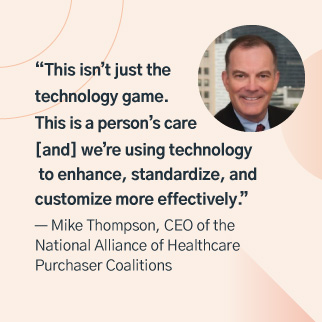
In a recent webinar, Dr. Andy Sekel, Ph.D., Twill's Chairman, discussed the status of the current behavioral health system, and asked a panel of experts what they would do to improve that system.
The video and transcript below is an excerpt from that webinar, titled “What Does 'Digital First' Mean for Behavioral Health and Can It Help Avoid The Mistakes of the Past?”
The three panelists who joined Dr. Sekel are all builders of systems that deliver healthcare to large populations of people.
Panelists included Steve Blumenfield, Head of Strategy and Innovation for Willis Towers Watson’s Health & Benefits business in North America; Dr. Stuart Lustig, Cigna’s National Medical Executive for Behavioral Health; and Michael Thompson, the President and CEO of the National Alliance of Healthcare Purchaser Coalitions.
In this excerpt from their discussion, the panelists discuss the need for human connection, through coaching and peer support, and both the promise and shortcomings of current existing digital solutions that feature gamification, educational content, coaches, and chat bots.
The complete webinar is available here.
Webinar Excerpt Transcript
Dr. Andy Sekel: How satisfied are you with what's out in the market in terms of digital tools for mental health and what recommendations do you have to improve them if you're not satisfied?
Dr. Stuart Lustig: I'll start with that. I'll answer the question from Cigna's perspective. We have a lot of digital tools that we have available to our customers—Twill of course, being one of them—which we're very excited about because people can access just a massive amount of content on a range of topics, whether it's CBT or mindfulness or sleeping better, anxiety, whatnot.
And we have Talkspace. You mentioned earlier, Andy, that it gives people the capability of doing real-time, as well as asynchronous, therapy with a designated therapist. We also have coaching available through Ginger. And this I think is huge because not everybody needs a board-certified psychiatrist or a licensed psychologist, or whatever the qualification is, but they do need help.
They do need some help thinking about a different situation or a situation differently. And so coaches fill that void and also help get people to a professional when they need one, to a licensed clinician.

And then we have peer support available because sometimes what you really need is someone who has walked the walk to inspire you to go down that same journey. You don't need a clinician or even a formal coach, but you do want another human being.
So, I think there's a range of solutions that are out there. They all have a place in the ecosystem of digital capabilities.
That said, there are some 20,000 apps out there in the behavioral space alone. And the questions that come up—Andy, you and others on the call, have probably grappled with this. How do we ensure that they work, that they do good things, that they protect people's privacy, that they aren't delaying care that people need? So that it's not just a diversion when people really do need to get in?
These are the kinds of considerations, I think, that we have with any of the solutions that are out there, but I feel good about, in general, the larger landscape of digital capabilities right now.
Dr. Andy Sekel: How about you, Steve?
Steve Blumenfield: Yeah, I love that—a positive way to kick it off. I feel much the same. Maybe the path I'll take is to go into some of those examples. One of the things you asked about was what works and what can be improved.
If you start with the digital first, and I mean, pure digital self-care, let's say without another person engaged. Some solutions are gamified and some solutions are content-heavy.
What we find is the best experiences are those that can meet a person where they are, and engage them without going too much out of their expectation of their every day. A warm entry that doesn't hit them too hard with the game, or it doesn't hit them too hard with assessments, but gives them a warm, easy opening with content available to them.
It's always important to have good content, but the kind of solutions that have just pure content—read, read, read—you tend to lose people. So it's walking that line, right? So you can give people the easy gamification, you can give them the education. You can give them that comfortable front door in with tools and a bit of an assessment, but not overdoing any of that.
The biggest gap we find is when the assessments are onerous, moving up to the next level of care—what's that interaction? Are you talking to a chat bot? And if so, is it really contextually responsive? That's still not mastered. Chatbots are hard to master. There's some interesting ones out there, but at some point, you want to be connected with a human being if that's what you're looking for.
How asynchronous is that versus synchronous? That's issue one, if you send a note because you feel like you're having a panic moment and you get a response three hours later, that can feel hard, right? For some people, maybe you need to have some way to triage that through some chat bot element of it, or at least get some response to it.
So that timing issue is one you have to trade off against the scalability of these things. The second is how contextually relevant. The response for some solutions we have found, the person who's on the other side of the interaction is more of a coach, which is okay.
But if that coach is glued to a screen and intent on responding to the next thing they need to probe into, they can miss what the person needs. So, you know, and when I've demoed, I've at times said things like, “You know, like I'm not feeling great today. I really feel like there's something that happened yesterday that I need to talk about.”
And then the response back a couple hours later was “Tell me what you were doing at the time” or “Can you help me on a scale of one to five, how you're feeling right now” which is really irrelevant. Over time, maybe 24 hours, they might get to the point, but they didn't there. So those are some of the things I've seen as maybe the fall-downs in some of the solutions.
Mike Thompson: And you know, I'll just say, it's an area that's exploding. I mean, the number of innovations happening in this space are incredible and they're coming out all the time. I mean, it's amazing. What I think is self-limiting is if we think of digital first as being self-care only, because not everybody is going to engage in self-care.
And we need to be thinking more broadly about a system that is enabled with digital to perform more effectively. Different people are going to engage in that system with different mindsets and some are going to have different capabilities and all of that.

This is digital first, not digital last, right? This isn't just the technology game. This is a person’s care that we're dealing with. We're using technology to enhance and standardize and improve and customize more effectively if we're doing it right. And some of what Steve talked about is a flat line, a flat approach to dealing with complex individuals.
It has to be more adaptive if it's going to be responsive and effective. And the good news is some of them, some of these newer innovations are measuring their impact ongoing much better than any care we've had in the past. And so at least we know they're having impact.
You can watch the entire webinar here.
You May Also Like:
- An interview with Dr. Sekel: Where Mental Health Still Misses the Mark
- A letter from Twill's CMO: How to Transform Healthcare at Scale
- White Paper: How to drive 40% Digital Activation with Members


